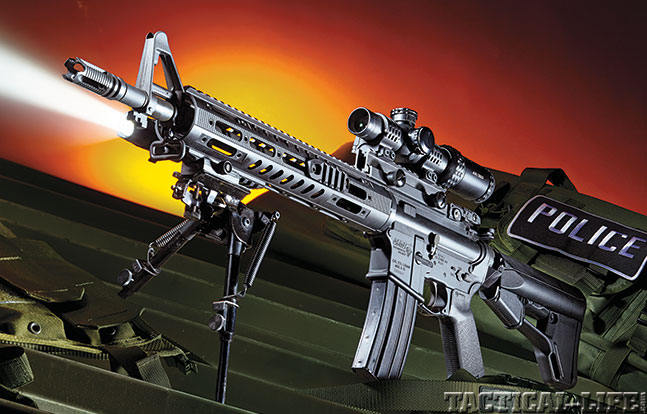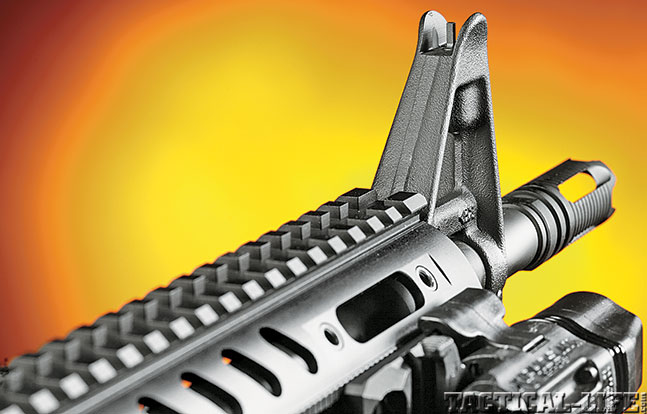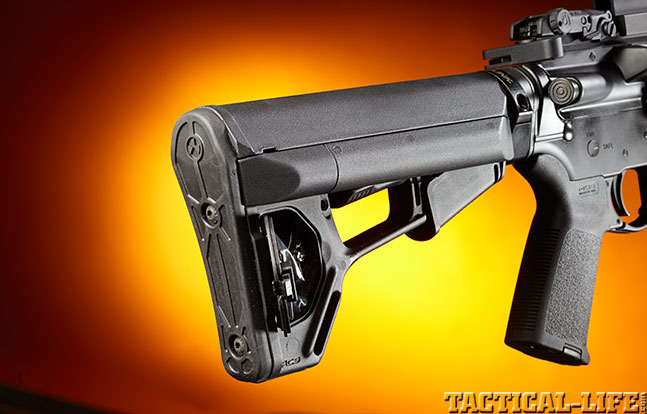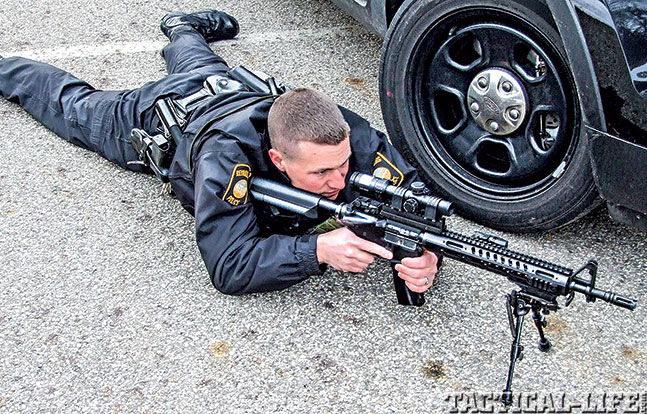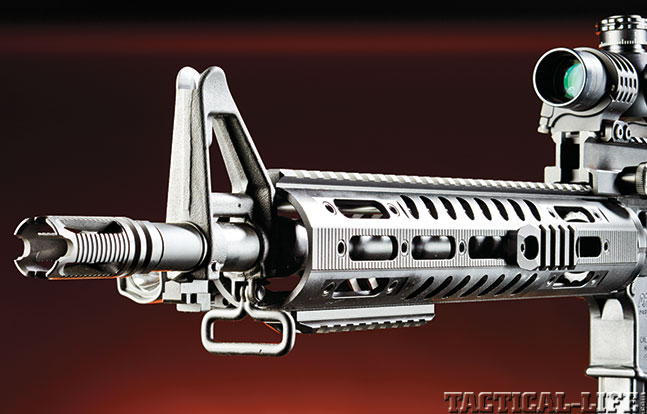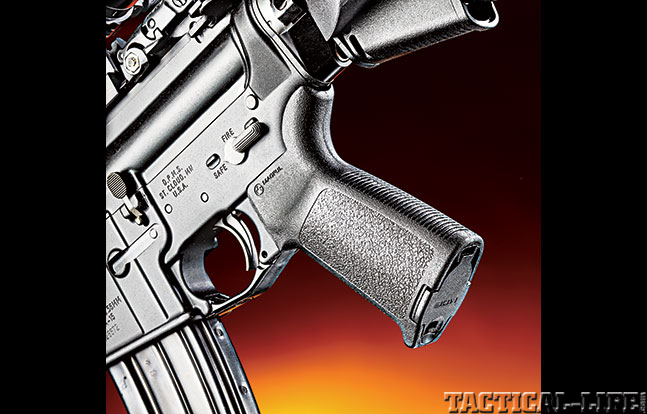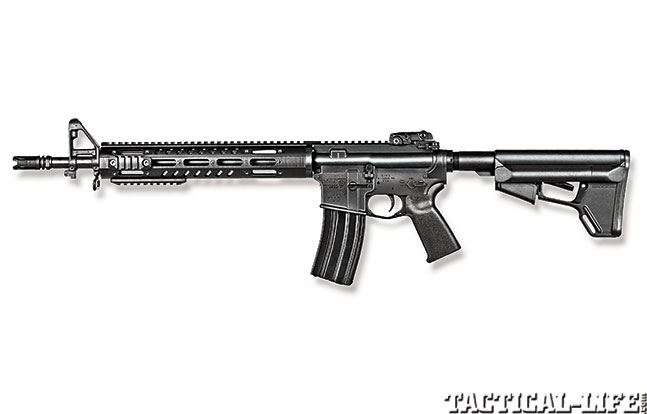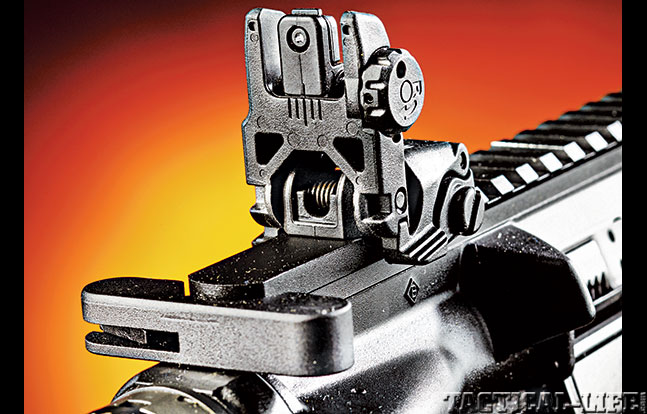From my perspective as a law enforcement officer, DPMS has long been one of my favorite AR-15 manufacturers. That’s right, it’s an actual manufacturer—not just an assembler—of AR-15 rifle systems. Still concentrating on the original direct gas impingement design, DPMS is known for its high quality and “married guy” prices. Back around 1998, when I wanted a personal AR-15 for use on the SWAT team but couldn’t afford to spend a lot, it was a DPMS carbine that accompanied me on some of my earliest SWAT missions. I have the utmost confidence in the company’s products.
I happen to like rifles and handguns that can fulfill multiple roles. In a day when dollars are tight for individual officers and law enforcement agencies alike, getting the most bang for the buck is a critical consideration when purchasing any firearm. The DPMS TAC2 is just such an AR—suitable for patrol, entry and long-range perimeter/containment duties. DPMS really covered all the bases when it designed the TAC2 carbine.
Advertisement — Continue Reading Below
Gun Details
When I unpacked the TAC2, the first thing that caught my attention was the fact that the forend did not look like a railway depot. The new DPMS M111 modular handguard system provides a trim, cylindrical gripping surface with a continuous top rail, short rail segments on the side and a longer segment on the bottom. The bottom and side segments can be moved to accommodate the end-user simply by loosening the Allen screws holding them in place. The forend runs most of the length of the barrel; it’s quick handling and comfortable. But the excellence doesn’t end there.
It’s pretty well accepted that the standard carbine-length gas system makes for a more abrupt action cycle with more carbon buildup than the original full-length gas tube. To smooth out the operational cycle, some manufacturers offer mid-length gas system configurations, which work quite well. DPMS went a step further with the TAC2 and mounted a full-length rifle gas system, which smoothes the cycling out as well as allows for the gas block/front sight base to be positioned farther down the barrel. This creates a longer sight radius when using iron sights, which provides a sharper sight picture.
Advertisement — Continue Reading Below
“High in utility and low in cost for the features it offers, the DPMS TAC2 can help a law enforcement officer succeed …”
When it comes to accuracy, the most important consideration is barrel stiffness, not length. The TAC2 features a 16-inch, 4150 steel, chrome-lined, lightweight barrel with a 1-in-9-inch twist rate and topped off by a Panther pronged flash suppressor. The carbine also comes with a fixed A2-style front sight assembly featuring a bayonet lug. DPMS chambered the TAC2 for the 5.56mm NATO, which means that both higher-pressure 5.56mm and the lower-pressure .223 ammo can be fired interchangeably. Unloaded, the TAC2 weighs 8.5 pounds—a bit heavier than I prefer for an entry or patrol rifle, but just about right for perimeter control or intermediate sniper work. Both the upper and lower receivers are forged from 7075-T6 aluminum.
The TAC2 is equipped with a Magpul ACS adjustable stock. The stock’s length-of-pull adjustment lever is shielded in the middle of the stock, and it has a sliding friction-lock lever that keeps it in your chosen position. The Magpul ACS is comfortable, solid and provides a good cheekweld. Once locked in position, it provides a very stable platform. For long-range precision, AR stocks with any amount of wobble in them are a no-go. The ACS features CR123 battery storage compartments accessible from the rear.
Advertisement — Continue Reading Below
In order make the TAC2 a weapon with true dual-purpose interoperability, I needed to find the right optic. Fortunately, Bushnell, which has really come a long way in the tactical precision optics field, had just the right sighting system: the new AR Optics 1-4x24mm Throw Down PCL scope.
Bushnell has long had a well-deserved reputation for providing quality sporting optics at reasonable prices. But sporting optics aren’t tactical optics, even though they may appear to function in a similar way. Sporting optics are not designed to function in life-or-death situations and don’t belong on a firearm that is designed to be used in just those situations. The new AR Optics Throw Down PCL is a true tactical optic designed for 5.56mm AR-platform weapons. Featuring solid construction and an illuminated Bushnell Tactical Reticle (BTR), the Throw Down PCL works well at any reasonable range, from contact distance to the 220-yard maximum effective range of the 5.56mm round, although the illuminated BTR reticle is designed to allow for holdovers out to 500 yards. While you can get hits with it at that range, no matter what bullet weight is used, the 5.56mm is running out of gas long before it reaches 500 yards. Bushnell recommends sighting in the Throw Down PCL at 100 yards.
At first glance, the Throw Down PCL looks like any other tactical optic of similar strength—until you note the power (zoom) control lever that is its namesake. I have worked with my fair share of rifle optics over the years, and have sometimes encountered zoom control rings that took a fair amount of effort to adjust. On one hand, the zoom stays where you want it and won’t easily be moved to a different setting. On the other hand, if you need to change the zoom quickly and, more importantly, smoothly, you won’t—especially in wet weather or when your hands are sweaty. The Power Control Lever solves that.
Advertisement — Continue Reading Below
Locking out of the way until you need it, the lever is activated by moving it up and away from the rear objective lens. Adjusting the zoom is very easy and precise. Once the zoom is set where you want it, simply fold the lever down to lock the setting in place. In my opinion, the Throw Down PCL is the standard by which other tactical optics should be judged just on this feature alone.
The BTR reticle can best be described as a small dot within a partial circle, where the six o’clock portion of the circle has been left open. A vertical line extends down from the central dot towards the six o’clock, with four holdover horizontal stadia lines intersecting the vertical line. The reticle array enlarges as the zoom is increased from 1-4X magnification.
There are 11 illumination settings. Normally, the reticle color is black in bright sunlight. As ambient light decreases, the reticle begins to adjust automatically and changes from black to red. The color change moves from subdued to increasingly brighter shades of red, with overall brightness controlled by the setting of the control switch.
Advertisement — Continue Reading Below
There were only three additions left to make the TAC2 multi-mission capable. For long-range perimeter control, I thought that an adjustable bipod would be just the ticket. I didn’t want to use a vertical foregrip on such a handy forend, so I went with a Shooter’s Ridge Deluxe Bipod and mounted it on a sling swivel rail adaptor. Lightweight and compact, the bipod can be deployed quickly in situations where an officer would be on post for long periods of time. Yet the folded profile is low enough so as not to interfere with the TAC2 if an entry mission is required.
If the TAC2 were to be used as a dedicated perimeter control rifle, I would outfit it with a carry type of sling. But when setup for dual use, that type of sling won’t cut it; a single-point sling is more in order. I fitted the TAC2 with my favorite single-point design from Tactical Link. Tactical Link’s Z-360 GEN 1 two-piece mount allows for quick and easy installation on any mil-spec stock tube using two Allen screws. Simply clamp the two halves over and under the tube, tighten the screws, and you are ready to go. The quick-release sling port is at the bottom of the mount, and it allows the sling to easily transition for use on the left or right side and provides central access for quick release if needed.
The final addition was a weapon light. But with an unloaded weight now in the 10.8-pound range, I didn’t want to add much more, which led me to use the updated BlackHawk Night-Ops Xiphos NTX weapon light. Upgraded last year from the original 90-lumen rating to a more stout 180 lumens, the polymer-bodied light uses only one CR123 battery. The Xiphos NTX is very compact, has a strobe mode and weighs only 2.5 ounces with the battery installed.
Advertisement — Continue Reading Below
Range Time
After sighting in the Bushnell scope, the TAC2 turned out to be everything I had hoped for and expected in a dual-mission AR. The narrow forend allows for excellent “swing-ability” when moving from target to target in rapid double-tap fire drills, even with the carbine’s relatively heavy weight. With the scope set at 1X magnification, it was easy to identify targets from contact distance out to 100 yards. Firing from prone with the scope at the 4X setting and using the bipod, the TAC2 turned in groups right at an inch or less, even with the Federal American Eagle XM855 62-grain FMJ practice ammo and the new, brass-cased, 62-grain (SS109) HotShot Elite 5.56mm NATO loads from Century International Arms. Wilson Combat’s 77-grain HPBT rounds, being the heaviest loads tested from the 1-in-9-inch-twist barrel, turned in (as expected) groups right around 1.25 inches. I’ve found that while the 1-in-9-inch twist rate accommodates the widest range of bullet weights, bullets heavier than 69 grains are at their best in 1-in-7-inch-twist barrels.
The best accuracy was obtained with Federal Premium Tactical 55-grain JSP rounds, with a group measuring 0.8 inches. Regardless of the round selected, this is stellar accuracy considering the fact that the trigger is pretty much a standard mil-spec unit. If you wanted to use the TAC2 as a dedicated precision rifle, you certainly could swap the trigger out for something lighter.
Advertisement — Continue Reading Below
The TAC2 represents another excellent AR-platform rifle design from DPMS. It ships with one 30-round magazine. For use as a precision rifle, I would use 20-round magazines, since their shorter length will not interfere with prone shooting positions. High in utility and low in cost for the features it offers, the DPMS TAC2 carbine in 5.56mm NATO can help a law enforcement officer succeed in several types of missions.
For more information, visit dpmsinc.com or call 800-578-3767.
